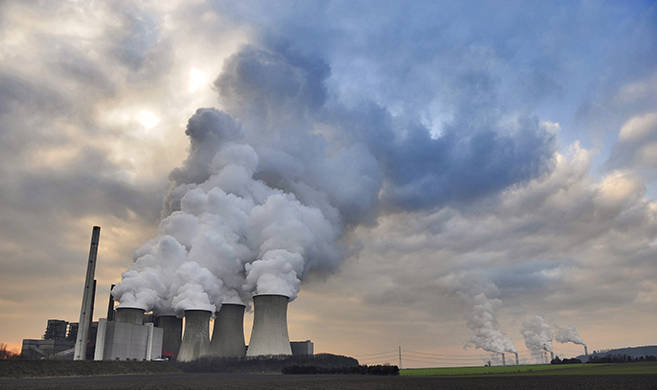Calculating carbon footprints has become standard procedure, and they are now routinely reported by organizations according to international accounting standards to allow consumers to make better purchase decisions. Marketing can play an important role in this, through developing products and services that have a low carbon footprint—the climate impact measured in carbon dioxide equivalent (CO2eq) emissions.
Our analysis starts from the observation that reducing the product carbon footprint not only has an effect on a firm’s costs, but also on demand. That is, while greener products tend to be more costly to produce, consumers tend to purchase more at a given price when products have a lower carbon footprint.
Optimal marketing strategy
We consider a firm that chooses the carbon footprint and the price of the product (or service) given the climate concerns of consumers. First, if lowering the carbon footprint reduces unit cost, then it is optimal to increase efficiency by eliminating waste. Such green cost cutting is even more attractive to the firm if lowering the carbon footprint not only reduces cost, but also increases demand due to better environmental performance of the product.
Second, if lowering the carbon footprint increases unit cost, there may be a tradeoff between the cost effect and the demand effect. Clearly, without a positive demand effect, lowering the carbon footprint only raises costs and is therefore suboptimal. However, when consumers are sufficiently responsive to the better environmental performance of the product, it may be optimal for the firm to engage in cost-increasing sustainability and offer a product with a lower carbon footprint.
Stronger climate concerns may lead to greener product design…
Stronger climate concerns increase the demand effect and the incentive to engage in cost-increasing sustainability. At the same time, the cost effect motivates the firm to increase price, which results in lower demand. Taken together, these demand and supply-side effects jointly determine the relative profitability of adjusting the carbon footprint and price.
In a market where the demand effect outweighs the cost effect, stronger climate concerns provide an incentive for the firm to design a greener product with a lower carbon footprint. In general, though, stronger climate concerns do not necessarily motivate firms to offer a greener product in the marketplace because the cost effect may outweigh the demand effect.
…but may increase the organizational carbon footprint
The optimal marketing strategy determines the overall climate impact of a firm—the organizational carbon footprint. This aggregate environmental impact is the result of multiplying the product carbon footprint by overall sales.
Surprisingly, we find that offering a greener product in response to stronger climate concerns does not necessarily reduces a firm’s overall level of carbon emissions. This occurs because the demand effect of lowering the carbon footprint may translate into higher sales and thus a greater organizational footprint—a situation where a firm that offers a greener product becomes a victim of its own success.
Surprisingly, we find that offering a greener product in response to stronger climate concerns does not necessarily reduces a firm’s overall level of carbon emissions.
Designing greener products can therefore be in conflict with the objective of meeting climate targets mandated by law. This points to a potential tension between the objectives of marketers and their senior manager and their seniors who are in charge of reducing the organization’s climate impact.
Carbon regulation: caps and taxes*
Governments are increasingly putting a price on carbon emissions to make firms pay for their impact on the climate—costs that are otherwise born by society. We study how cap-and-trade systems and carbon taxes affect the optimal marketing strategy.
A cap-and-trade system allows a firm to choose between two options: adjust its marketing strategy to meet the limit set by the regulator at the organizational level, or stick to the current marketing strategy and decisions about the carbon footprint and price and purchase carbon allowances in an emissions market.
While a binding carbon cap clearly reduces the organizational carbon footprint and firm profit, the impact on the carbon footprint at the product level is ambiguous. This results from the fact that the firm has an incentive to increase the carbon footprint and thereby purposely reduce sales to meet the carbon target (demarketing). Therefore, a carbon regulation at the organizational level may have the unintended consequence of increasing the product carbon footprint. In contrast, purchasing carbon allowances reduces profit only but has no impact on the optimal marketing strategy.
An alternative to carbon caps are carbon taxes that put a price on the organizational carbon footprint without restricting its overall emissions. Typically, a carbon tax reduces firm profit but has an ambiguous impact on the organizational footprint because the product’s lower carbon footprint increases sales and, as a consequence, overall emissions.
Stimulating green technology adoption
The need to comply with carbon regulation may trigger investments in green technologies that allow a firm to produce a product with the same carbon footprint at lower cost. Our analysis shows that higher uncertainty about the likelihood of carbon regulation relaxes the standard condition under which the new technology is adopted. Thus, the mere threat of carbon regulation may lead to the adoption of a green technology, greener product design, and a lower organizational carbon footprint.
The mere threat of carbon regulation may lead to the adoption of a green technology.
This insight has an important policy implication: Regulatory pressure can provide incentives for marketing managers and firms to do the right thing for the climate by offering greener products—the standard link from regulation to promoting innovation.
Key findings
Climate concerns of consumers and governments provide incentives to reduce the carbon footprint of products and organizations. However, in many plausible cases, overall emissions can increase due to the increase in demand for products with a lower product carbon footprint—a case where marketers become victim of their own success.
Climate concerns of consumers and governments provide incentives to reduce the carbon footprint of products and organizations.
Importantly, the logic here can be applied beyond carbon emissions. Examples include other pollutants and water or plastic footprints, and ecological footprints more broadly, which all play an important role in the management of corporate social responsibility (CSR).
Appendix: Carbon Transparency
Some firms disclose the carbon footprint (or CO2 emissions) of their products and services as part of their communication strategy. The footprint can be reported at the organizational level or at the product level.
For example, Carlsberg Group, promotes “zero carbon emissions” for breweries, and a “30% reduction in beer-in-hand carbon footprint.” Dell shares the carbon footprint of each of their products based on their lifecycle emissions, shows where they can improve, and invites their customers to “do the same.”
Toshiba explains that it attempts to offset “the amount of CO2 released into the atmosphere by balancing or cancelling out the amount of these gases through participation in environmental projects." Finally, Evian claims that it “crushes the carbon footprint with lighter, easier-to-recycle bottle.”
Facebook has a page dedicated to sustainability where they state their collaborations with companies, nonprofits, and coalitions on sustainability solutions. There, they also share information on greenhouse gas emissions.
*Cap-and-trade schemes and carbon taxes: A cap-and-trade scheme issues a set number of emission “allowances” each year (learn more about the EU program here). In contrast, a carbon tax directly establishes a price on greenhouse gas emissions, so companies are charged for all their emissions they produce (learn more here.)
**The British NGO Carbon Trust has created a CO2 label and has become a major player in carbon certification.










